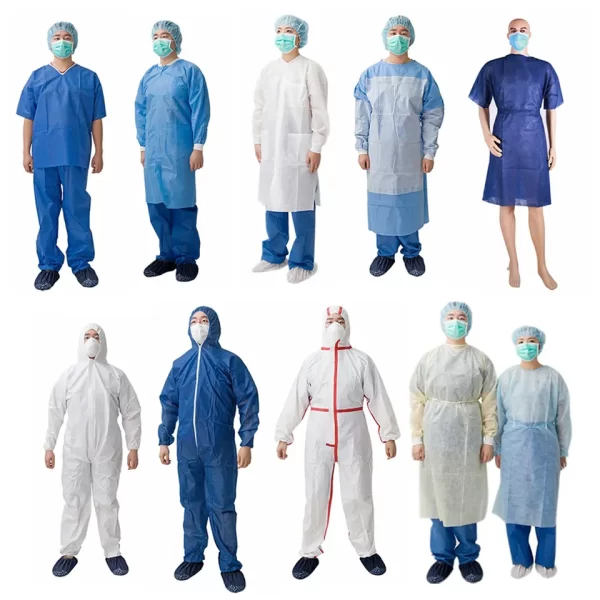What Materials are Commonly Used in the Manufacture of Disposable Gowns?
Introduction
Disposable gowns are a critical component of personal protective equipment (PPE) used in healthcare settings. They serve as a barrier, protecting healthcare workers and patients from the spread of infectious agents. The materials used in the manufacture of these gowns are chosen for their ability to provide a barrier to fluids and microorganisms. This article will delve into the common materials used in the manufacture of disposable gowns and their respective properties.
Nonwoven Fabrics
The majority of disposable gowns are made from nonwoven fabrics. Nonwoven fabrics are sheets or webs of fibers, bonded together by entangling the fibers mechanically, thermally, or chemically. They are flat, porous sheets that are made directly from separate fibers or from molten plastic or plastic film. They do not require the conversion of fibers into yarn.
Nonwoven fabrics are chosen for their specific properties, which can include absorbency, liquid repellence, resilience, stretch, softness, strength, flame retardancy, washability, cushioning, thermal insulation, acoustic insulation, filtration, use as a bacterial barrier, and sterility. These properties are often combined to create fabrics suited for specific jobs, with a good balance of use-life and cost. They are designed to be single-use, which is often necessary for medical applications.
Polypropylene
One of the most common materials used in the manufacture of disposable gowns is polypropylene. Polypropylene is a type of plastic, and it is used in a variety of applications, including packaging, textiles, and reusable containers. In the context of disposable gowns, polypropylene is often used because it is resistant to liquids and microorganisms, making it an effective barrier against potential contaminants in a healthcare setting.
Polyethylene
Another common material used in the manufacture of disposable gowns is polyethylene. Like polypropylene, polyethylene is a type of plastic. It is often used in the manufacture of disposable gowns because it can be made into a thin, lightweight fabric that is impermeable to liquids and microorganisms. This makes it an effective barrier against potential contaminants.
SMS (Spunbond Meltblown Spunbond)
SMS stands for Spunbond Meltblown Spunbond. This is a type of nonwoven fabric that combines two layers of spunbond polypropylene with a layer of meltblown polypropylene in the middle. The spunbond layers provide strength and durability, while the meltblown layer provides a barrier against microorganisms and liquids. SMS is often used in the manufacture of disposable gowns because it offers a high level of protection while still being comfortable and breathable.
Levels of Medical Gowns
When choosing gowns, it’s important to look for product labeling that describes the intended use with the desired level of protection based on the risk levels. The FDA recognizes the consensus standard American National Standards Institute/Association of the Advancement of Medical Instrumentation (ANSI/AAMI) PB70, which establishes a system of classification for protective apparel and drapes used in healthcare facilities based on their liquid barrier performance. This standard specifies related labeling requirements and standardized test methods for determining compliance.
The standard assists end-users in determining the type(s) of protective product most appropriate for a particular task or situation:
- Level 1: Minimal risk, to be used, for example, during basic care, standard isolation, cover gown for visitors, or in a standard medical unit
- Level 2: Low risk, to be used, for example, during blood draw, suturing, in the Intensive Care Unit (ICU), or a pathology lab
- Level 3: Moderate risk, to be used,for example, during arterial blood draw, inserting an Intravenous (IV) line, in the Emergency Room, or for trauma cases
- Level 4: High risk, to be used, for example, during long, fluid intense procedures, surgery, when pathogen resistance is needed or infectious diseases are suspected (non-airborne)
Surgical Gowns
A surgical gown is regulated by the FDA as a Class II medical device that requires a 510(k) premarket notification. A surgical gown is a personal protective garment intended to be worn by health care personnel during surgical procedures to protect both the patient and health care personnel from the transfer of microorganisms, body fluids, and particulate matter. Because of the controlled nature of surgical procedures, critical zones of protection have been described by national standards.
As referenced in Figure 1: the critical zones include the front of the body from top of shoulders to knees and the arms from the wrist cuff to above the elbow. All surgical gowns must be provided sterile and labeled as a surgical gown. The entire front of the gown (areas A, B, and C) is required to have a barrier performance of at least level 1. The critical zone compromises at least areas.
Conclusion
In conclusion, the materials used in the manufacture of disposable gowns are chosen for their ability to provide a barrier to fluids and microorganisms. Nonwoven fabrics, polypropylene, polyethylene, and SMS are all commonly used due to their specific properties. These materials, combined with proper gown design and manufacturing processes, ensure that disposable gowns provide the necessary protection in healthcare settings.
As the demand for disposable gowns continues to grow, manufacturers are continually innovating to create products that meet these needs. From developing new materials that offer superior protection and comfort, to designing gowns that are easier to don and doff, to finding ways to make products more sustainable, the future of disposable gowns is one of continuous improvement and innovation.
Please visit our website for more product details https://medposnonwoven.com/product-category/protective-gowns/

